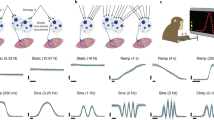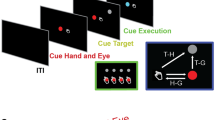Abstract
What neural activity in motor cortex represents and how it controls ongoing movement remain unclear. Suggestions that cortex generates low-level muscle control are discredited by correlations with higher-level parameters of hand movement, but no coherent alternative exists. I argue that the view of low-level control is in principle correct, and that seeming contradictions result from overlooking known properties of the motor periphery. Assuming direct motor cortical activation of muscle groups and taking into account the state dependence of muscle-force production and multijoint mechanics, I show that cortical population output must correlate with hand kinematics in quantitative agreement with experimental observations. The model reinterprets the ‘neural population vector’ to afford unified control of posture, movement and force production.
This is a preview of subscription content, access via your institution
Access options
Subscription info for Japanese customers
We have a dedicated website for our Japanese customers. Please go to natureasia.com to subscribe to this journal.
Buy this article
- Purchase on SpringerLink
- Instant access to full article PDF
Prices may be subject to local taxes which are calculated during checkout






Similar content being viewed by others
References
Evarts, E. V. in Handbook of Physiology (ed. Brooks, V. B.) 1083– 1120 (Williams and Wilkins, Baltimore, 1981).
Johnson, P. B. in Control of Arm Movement in Space: Neurophysiological and Computational Approaches (eds. Caminiti, R., Johnson, P. B. & Burnod, Y.) (Springer, Berlin, 1992).
Evarts, E. Relation of pyramidal tract activity to force exerted during voluntary movement . J. Neurophysiol. 31, 14– 27 (1968).
Dum, R. P. & Strick, P. L. The origin of corticospinal projections from the premotor areas in the frontal lobe. J. Neurosci. 11, 667–669 (1991).
Fetz, E. E. & Cheney, P. D. Postspike facilitation of forelimb muscle activity by primate corticomotoneuronal cells. J. Neurophysiol. 44, 751–772 ( 1980).
Georgopoulos, A., Kalaska, J., Caminiti, R. & Massey, J. On the relations between the direction of two-dimensional arm movements and cell discharge in primate motor cortex. J. Neurosci. 2, 1527–1537 (1982).
Schwartz, A. B. Direct cortical representation of drawing. Science 265, 540–542 (1994).
Moran, D. W. & Schwartz, A. B. Motor cortical representation of speed and direction during reaching. J. Neurophysiol. 82, 2676–2692 (1999).
Kalaska, J. F., Cohen, D. A. D., Hyde, M. L. & Prud'homme, M. A comparison of movement direction-related versus load direction-related activity in primate motor cortex, using a two-dimensional reaching task. J. Neurosci. 9, 2080–2102 (1989).
Sergio, L. E. & Kalaska, J. F. Changes in the temporal pattern of primary motor cortex activity in a directional isometric force versus limb movement task. J. Neurophysiol. 80, 1577 –1583 (1998).
Kettner, R. E., Schwartz, A. B. & Georgopoulos, A. P. Primate motor cortex and free arm movements to visual targets in three-dimensional space III. Positional gradients and population coding of movement direction from various movement origins. J. Neurosci. 8, 2938–2947 ( 1988).
Flament, D. & Hore, J. Relations of motor cortex neural discharge to kinematics of passive and active elbow movements in the monkey. J. Neurophysiol. 60, 1268–1284 (1988).
Thach, W. T. Correlation of neural discharge with pattern and force of muscular activity, joint position, and direction of intended next movement in motor cortex and cerebellum. J. Neurophysiol. 41, 654– 676 (1978).
Alexander, G. E. & Crutcher, M. D. Neural representations of the target (goal) of visually guided arm movements in three motor areas of the monkey. J. Neurophysiol. 64, 164– 178 (1990).
Fu, Q.-G., Flament, D., Coltz, J. D. & Ebner, T. J. Temporal encoding of movement kinematics in the discharge of primate primary motor and premotor neurons. J. Neurophysiol. 73, 836–854 (1995).
Hocherman, S. & Wise, S. P. Effects of hand movement path on motor cortical activity in awake, behaving rhesus monkeys. Exp. Brain Res. 83, 285–302 ( 1991).
Humphrey, D. R. & Reed, D. J. in Advances in Neurology: Motor Control Mechanisms in Health and Disease (ed. Desmedt, J. E.) 347–372 (Raven, New York, 1983).
Carpenter, A. F., Georgopoulos, A. P. & Pellizzer, G. Motor cortical encoding of serial order in a context-recall task. Science 283, 1752– 1757 (1999).
Georgopoulos, A. P., Lurito, J. T., Petrides, M., Schwartz, A. B. & Massey, J. T. Mental rotation of the neuronal population vector. Science 243, 234– 236 (1989).
Scott, S. & Kalaska, J. Changes in motor cortex activity during reaching movements with similar hand paths but different arm postures . J. Neurophysiol. 73, 2563– 2567 (1995).
Ashe, J. & Georgopoulos, A. P. Movement parameters and neural activity in motor cortex and Area 5. Cereb. Cortex 6, 590–600 (1994).
Fetz, E. E. Are movement parameters recognizably coded in the activity of single neurons? Behav. Brain Sci. 15, 679– 690 (1992).
Joyce, G. C., Rack, P. M. H. & Westbury, D. R. The mechanical properties of cat soleus muscle during controlled lengthening and shortening movements. J. Physiol. (Lond.) 204, 461–474 ( 1969).
Zajac, F. E. Muscle and tendon: properties, models, scaling, and application to biomechanics and motor control. Crit. Rev. Biomed. Eng. 17, 359–411 (1989).
Winter, D. A. Biomechanics and Motor Control of Human Movement (Wiley, New York, 1990).
Hubel, D. H. & Wiesel, T. N. Receptive fields, binocular interaction and functional architecture in the cat's visual cortex. J. Physiol. (Lond.) 160, 106–154 ( 1962).
Crammond, D. J. & Kalaska, J. F. Differential relation of discharge in primary motor cortex and premotor cortex to movements versus actively maintained postures during a reaching task. Exp. Brain Res. 108, 45–61 ( 1996).
Kalaska, J. F. & Crammond, D. J. Cerebral cortical mechanisms of reaching movements. Science 255, 1517–1523 (1992).
Kalaska, J. F., Crammond, D. J., Cohen, D. A. D., Prud'homme, M. & Hyde, M. L. in Control of Arm Movement in Space: Neurophysiological and Computational Approaches (eds. Caminiti, R., Johnson, P. B. & Burnod, Y.) (Springer, Berlin, 1992).
Taira, M., Boline, J., Smyrnis, N., Georgopoulos, A. & Ashe, J. On the relations between single cell activity in the motor cortex and the direction and magnitude of three-dimensional static isometric force. Exp. Brain Res. 109, 367– 376 (1996).
Bennett, D. J., Hollerbach, J. M., Xu, Y. & Hunter, I. W. Time-varying stiffness of human elbow joint during cyclic voluntary movement . Exp. Brain Res. 88, 433– 442 (1992).
Bullock, D., Cisek, P. & Grossberg, S. Cortical networks for control of voluntary arm movements under variable force conditions. Cereb. Cortex 8, 48–62 (1998).
Caminiti, R., Johnson, P. & Urbano, A. Making arm movements within different parts of space: dynamic aspects in the primate motor cortex. J. Neurosci. 10, 2039–2058 (1990).
Scott, S. & Kalaska, J. Reaching movements with similar hand paths but different arm orientation. I. Activity of individual cells in motor cortex. J. Neurophysiol. 77, 826 –852 (1997).
Tanaka, S. Hypothetical joint-related coordinate systems in which populations of motor cortical neurons code direction of voluntary arm movements. Neurosci. Lett. 180, 83–86 ( 1994).
Kakei, S., Hoffman, D. & Strick, P. Muscle and movement representations in the primary motor cortex. Science 285, 2136– 2139 (1999).
Fetz, E. E., Cheney, P. D., Mewes, K. & Palmer, S. Control of forelimb muscle activity by populations of corticomotoneuronal and rubromotoneuronal cells. Prog. Brain Res. 80, 437– 449 (1989).
Miller, L. E. & Sinkjaer, T. Primate red nucleus discharge encodes the dynamics of limb muscle activity. J. Neurophysiol. 80, 59–70 (1998).
Gottlieb, G. L. On the voluntary movement of compliant (inertial-viscoelastic) loads by parcellated control mechanisms. J. Neurophysiol. 76, 3207–3228 (1996).
Khatib, O. A unified approach to motion and force control of robotic manipulators: the operational space formulation. IEEE J. Robotics Automat. RA-3, 43–53 (1987).
Scott, S. H. Comparison of onset time and magnitude of activity for proximal arm muscles and motor cortical cells before reaching movements. J. Neurophysiol. 77, 1016–1022 ( 1997).
Bizzi, E., Mussa-Ivaldi, F. A. & Giszter, S. F. Computations underlying the execution of movement: a biological perspective. Science 253, 287 –291 (1991).
Galagan, J. Spinal Mechanisms of Motor Control. Thesis, MIT (1999 ).
Tsuji, T., Morasso, P. G., Goto, K. & Ito, K. Human hand impedance characteristics during maintained posture. Biol. Cybern. 72, 475–485 (1995).
Gomi, H. & Kawato, M. Equilibrium-point control hypothesis examined by measured arm stiffness during multijoint movement. Nature 272, 117–120 ( 1996).
Wolpert, D., Gharahmani, Z. & Jordan, M. An internal model for sensorimotor integration. Science 269, 1880–1882 ( 1995).
Mussa-Ivaldi, F. A. Do neurons in the motor cortex encode movement direction? An alternative hypothesis . Neurosci. Lett. 91, 106– 111 (1988).
Schmidt, R. A., Zelaznik, H., Hawkins, B., Frank, J. S. & Quinn, J. T. J. Motor-output variability: a theory for the accuracy of rapid motor acts. Psychol. Rev. 86, 415–451 (1979).
Sanes, J. N. & Shadmehr, R. Sense of muscular effort and somatesthetic afferent information in humans. Can. J. Physiol. Pharmacol. 73, 223–233 (1995).
Fu, Q.-G., Suarez, J. & Ebner, T. Neuronal specification of direction and distance during reaching movements in the superior precentral premotor area and primary motor cortex of monkeys. J. Neurophysiol. 70, 2097–2116 (1993).
Acknowledgements
I thank Zoubin Ghahramani and Stephen Scott for their suggestions.
Author information
Authors and Affiliations
Corresponding author
Rights and permissions
About this article
Cite this article
Todorov, E. Direct cortical control of muscle activation in voluntary arm movements: a model. Nat Neurosci 3, 391–398 (2000). https://doi.org/10.1038/73964
Received:
Accepted:
Issue Date:
DOI: https://doi.org/10.1038/73964



